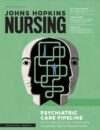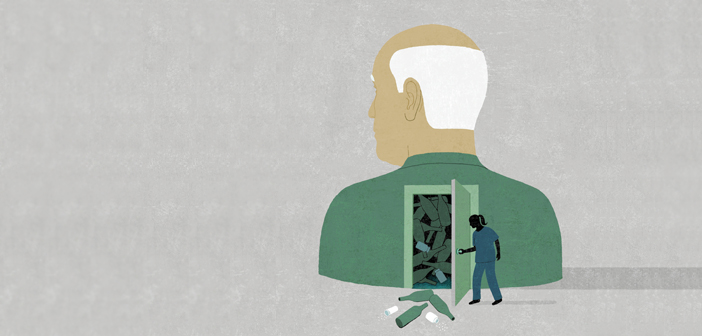What caregivers don’t know could hurt aging baby boomers
By Norine Schiller
A 70-year-old man suffers a heart attack and is brought into the Emergency Department. His medical history reveals cardiovascular disease, high cholesterol, and a previous heart attack in his 50s. On aspirin therapy for a year, he had stopped it three weeks earlier on his physician’s advice after reporting more cardiac discomfort and using more nitroglycerin just to get through the day.
He needs a cardiac bypass, which should take about five hours. But once surgery begins, so does uncontrolled bleeding. Finally, after 13 hours, the patient’s life has been saved, but he faces a complicated recovery, and the exhausted surgical team is left to wonder what went wrong.
Blame a potentially deadly and all-too-common cocktail, says Christine L. Savage, PhD, RN, CARN, professor and chair of the Department of Community-Public Health at the Johns Hopkins School of Nursing (JHSON). Alcohol is an anticoagulant. The patient had been a lifelong drinker and was still drinking daily. The doctor didn’t know about it because he didn’t ask. In addition, the patient had heard only “aspirin,” not “children’s aspirin,” so he had been taking a higher-than-prescribed dosage of that blood thinner. (Nitroglycerin also opens blood vessels to improve flow.)
Savage says this case study illustrates just one of the healthcare perils that lie around the corner for an aging baby boomer population, many of whom will bring substance use and its complications with them into their golden years. She explains that while misuse of prescription drugs or use of illicit drugs makes better headlines–and might be a legitimate and growing concern for the generations following boomers–alcohol overuse is a far greater and more widespread danger for this group and a significant challenge for caregivers today.
Baby boomers are more apt to be prescribed medications for various medical conditions, and these have the potential to interact with alcohol and thus increase the risk for adverse outcomes, Savage explains. “A separate issue is that though illicit drug use–including nonmedical use of prescription pain medication–is low in the 65-plus age group, it will increase as the baby boomers reach 65, with the majority of the use being marijuana.” She adds, “As we loosen the restrictions and it becomes culturally more accepted, do we really understand what happens to marijuana when you’re older and are less able to metabolize that?”
Simple Questions, Hard Answers
By 2015, all baby boomers will be 50 or older. In an editorial slated for the Journal of Addictions Nursing, Savage writes that, unlike members of previous generations, many of these individuals have been using alcohol and other drugs for their entire adult lives. There are consequences.
“Alcohol is a dirty drug, and it causes all kinds of long-term problems,” Savage says. Quoting a 2013 National Institute on Alcohol Abuse and Alcoholism report, she says alcohol contributes to increased risk for more than 65 diseases and conditions, including pancreatic, breast, and ear, nose, and throat cancers, liver disease, injuries, and cognitive impairment.
“It’s an equal opportunity problem that cuts across socioeconomic and gender lines,” adds Deborah Finnell, DNS, PMHNP-BC, CARN-AP, associate professor in the Department of Acute and Chronic Care at JHSON. “When people come in to healthcare, the best practice is to ask questions related to alcohol, tobacco, and other drug use. There are reliable and valid measures—very simple measures—that can be used” to screen for these issues. Unfortunately, she says, “those are not being widely implemented.”
Savage says, “We tend not to think about the older patient in front of us as somebody whose alcohol use may be putting them at risk, and we’re uncomfortable asking the cute grandmother or the stately older man about their alcohol use.”
Nancy Hodgson, PhD, RN, assistant professor in the JHSON Department of Acute and Chronic Care, emphasizes the importance of making the effort. That older patient could be experiencing “bereavement, isolation, loneliness, an underlying depression or pain, so they’re self-medicating as a numbing agent, using alcohol.”
Just as a pediatrician spends time talking to a child’s family, older patients need to be examined “so the person is understood within their context,” says Laura N. Gitlin, PhD, professor and director of the Center for Innovative Care in Aging at JHSON’s Department of Community-Public Health. The system incentivizes an acute-care approach, she says, when what is needed takes more time. “Insurers, what are they paying for? They’re paying for a six-minute visit. They’re paying for tests,” she says. “These aren’t tests. They are ways of talking to people and coming up with strategies that don’t require a chest X-ray or an MRI.”
Substance use disorders are a chronic problem, Gitlin says, much like diabetes or heart disease, but the healthcare system is unresponsive to chronic problems. Yet, chronic diseases and conditions are “the major health problem that will confront people as they age.”
In addition, she explains, “The doctor knows the person but is not necessarily attentive to how age, in and of itself, can make a difference in how the person metabolizes medication.”
One useful approach to screening and intervention is SBIRT (for Screening, Brief Intervention, and Referral to Treatment), which identifies patients with risky substance use, engages them in a brief conversation about that behavior, and refers those who need it to further treatment.
Finnell says this kind of screening should be standard practice, just like taking a patient’s blood pressure, pulse, and weight. She describes the brief intervention as a five- to 10-minute conversation that starts with “asking for permission to talk about it. Because of how society views alcohol and other drug use, it’s important to put people at ease.”
Hodgson says the nurse is the perfect person to start this conversation.
“Nurses can be the point of care,” she explains. “They have the rapport with the patients, they have the key assessment skills necessary to pick up the subtle changes—things like fall history, or unexplained lethargy or confusion—and dig deeper.”
“Older adults are probably more likely to talk to the nurse about more sensitive issues than they would perhaps the physician,” Hodgson adds. Nurses “are the eyes and the ears; they typically are the person that has a more intimate understanding of the patient.”
“The SBIRT model works really well,” Savage explains, but screening for current use has its limits. “The older adult who has used alcohol for a long period of time in their life, whether they are using currently or not, is at increased risk.” In her editorial, Savage writes that “the risk for medical complications may remain, even after the alcohol use has stopped.”
Savage describes a case in which an elderly patient in a physician’s office was “disoriented, acting weird, with their limbs going all over the place.” The physician assumed the patient had dementia. But a family member told the nurse that the patient had a long history of alcohol use.
“So this is the clue to the nurse,” Savage says. “The nurse says, ‘What about thiamin deficiency? Could this be Wernicke-Korsakoff?’” Over time, alcohol reduces the body’s ability to absorb and use thiamin, which can lead to Wernicke-Korsakoff syndrome. In this case, the nurse recognized the acute symptoms, alerted the physician, and helped the patient receive the necessary care.
[pullquote]
We have over 3 million nurses in the nation. If those 3 million nurses had all been appropriately educated, then we could make a huge impact.”
-Deborah Finnell, PMHNP-BC, CARN-AP
[/pullquote]
Leading the Way
Ultimately, Finnell says, the goal is for nurses to be able to identify every patient with risky substance use and to raise awareness. Patients “may say, ‘I’m going to continue to drink at the same level I’ve been drinking.’ But if I can get them, at least, to begin to think about that, then I see that as a real success.” And if they agree they should decrease their alcohol use, she says, “then that’s a greater success.”
Savage and Finnell are part of a team working on a Substance Abuse and Mental Health Services Administration-funded training grant to integrate more content about alcohol and drugs into the graduate curricula to prepare nurses to meet this challenge. (For a current study, Finnell has developed a 20-minute video illustrating how alcohol affects the brain. She hopes to use it with patients in primary care who are identified with at-risk alcohol use.)
“We want for nurses who graduate from the Johns Hopkins School of Nursing to be leaders in the nation for moving this set of clinical strategies … across all healthcare settings, all populations, all settings,” Finnell says, adding that working nurses also need this education.
“We have over 3 million nurses in the nation,” Finnell says. “If those 3 million nurses had all been appropriately educated, then we could make a huge impact in terms of the global harm associated with alcohol use.”
Boomers, Alcohol, and Drugs
Those interested in alcohol and drug use among baby boomers and learning how to prevent negative outcomes can look forward to a five-week massive open online course, or MOOC, to be taught in June by Christine Savage, PhD, RN, CARN. The target audience for the course includes clinicians, but also those who are living with or through the experience. Register for MOOC.

